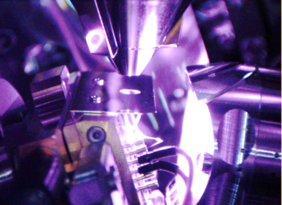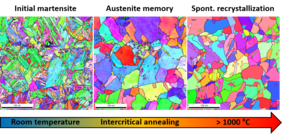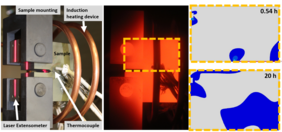Together with partners, the Materials Center Leoben has developed a variety of material models in recent years to predict process-microstructure-property relationships for developing new materials, manufacturing processes or components. As models need to become more complex and accurate, characterization techniques must also evolve to validate these new models and determine reliable model parameters. In the following, two novel characterization techniques for model validation and parameter determination are presented as examples.
High temperature electron backscatter diffraction for validation of austenite grain-growth models
A new austenite grain-growth model was developed in order to predict the austenite grain size evolution during the austenitization treatment of a high-alloyed steel. In order to validate the austenite grain-growth model and to determine required input parameters, high temperature electron backscatter diffraction (HT-EBSD) measurements were conducted. The in situ HT-EBSD observation during heating to austenitization temperature, illustrated in Fig.1, reveals novel phenomena for this steel alloy such as the austenite memory effect (i.e. the formation of new austenite grains during austenitization with the same crystal orientation, size and shape as the prior austenite grain – Fig.1b) and subsequent spontaneous recrystallization (i.e. recrystallization of austenite without previous deformation – Fig.1c).
The HT-EBSD results enabled the determination of the initial grain size (after spontaneous recrystallization) for the austenite grain-growth model and improved the prediction of austenite grain size evolution during austenitization. The implementation of a spontaneous recrystallization model is ongoing research.
Computer-aided characterization of creep fracture mechanical properties at elevated temperatures
The determination of fracture mechanical properties at elevated temperatures for model validation is challenging due to large-scale plasticity and creep. Creep causes time-dependent specimen conditions (i.e. strain and stress) and complicates classical elasto-plastic fracture mechanics approaches. Therefore, a new computer-aided testing technique was developed that includes the calculation of time-dependent specimen conditions (e.g. equivalent creep strain) using finite element modeling (FEM). The experimental setup is shown in Fig.2a at room temperature and in Fig. 2b at the testing temperature of 700°C under constant tension of 25 kN. The area for the corresponding FEM calculations is highlighted by a yellow rectangle. The results of the FEM calculation for the time-dependent equivalent creep strain are shown in Fig. 2c for 0.54 h and Fig. 2d for 20 h. The combination of experiment and simulation allows the characterization of fracture mechanical properties at temperatures up to 1000°C by correcting the experimental data according to the creep strain.
Project coordination (Story)
Dr. Dominik Brandl
Junior Researcher Steel Engineering
Department Materials
T +43 (0) 3842 45922 - 62
dominik.brandl(at)mcl.at
Project partner
Erich Schmid Institute of Materials Science, Austrian Academy of Sciences, Austria University of Maribor, Slovenia





















